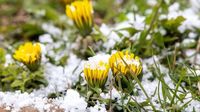The annual phenomenon known as the Eisheiligen, or Ice Saints, is once again capturing the attention of gardeners and farmers as it approaches from May 11 to May 15, 2025. Traditionally feared for the cold spells they bring, these days have long been associated with the risk of frost that can threaten young plants and crops.
According to MeteoSchweiz, the Eisheiligen correspond to the name days of four early Christian bishops and martyrs: Mamertus (May 11), Pankratius (May 12), Servatius (May 13), and Bonifatius (May 14), concluding with Kalte Sophie (Cold Sophie) on May 15. Historically, these dates marked a time when cold air outbreaks were regularly observed in mid-May, leading to concerns about late frosts that could devastate crops.
However, the scientific basis for the Eisheiligen phenomenon is debated. MeteoSchweiz notes that while frost days in May are common, the specific phenomenon of the Eisheiligen lacks scientific validation. "The weather rule that is supposed to occur on certain days in May cannot be confirmed with our measurement series," a representative from MeteoSchweiz stated. Nonetheless, they acknowledge that ground frost can still occur throughout May.
Interestingly, the dates of the Eisheiligen have shifted due to the Gregorian calendar reform of 1582. Originally, the Eisheiligen fell later in the month, but the reform moved them approximately ten days earlier. Today, with the calendar adjustment considered, the Eisheiligen would actually start on May 19, with Cold Sophie on May 23, as pointed out by experts.
As the Eisheiligen approach in 2025, many are left wondering whether they should plant their gardens or wait for the potentially damaging frost to pass. The German Weather Service (DWD) has released forecasts indicating that while some frost may still occur, May 2025 is generally expected to be mild and wet. According to meteorologist Jörg Riemann, the Eisheiligen are anticipated to arrive "early" this year, similar to the previous year when cold spells were already noted in April.
Weather forecasts suggest that temperatures will rise steadily, with daytime highs expected to range from 16 to 24 degrees Celsius. Nighttime lows could drop to around 0 degrees Celsius, particularly in areas like the Bavarian Forest. However, widespread nighttime frosts typical of the Eisheiligen are not anticipated. Instead, isolated cold nights may occur, especially under clear skies and high pressure.
Despite the promising forecast, the risk of frost remains a concern for gardeners and farmers. The Eisheiligen have historically posed a significant threat to crops, with reports from the 1940s and 50s noting nighttime lows as low as -11 degrees Celsius during this period. Even today, crops such as tomatoes, strawberries, and vineyards are particularly vulnerable to frost damage.
For those who have already planted, experts advise covering sensitive plants with protective materials like fleece or plastic during cold nights. The old farmer's saying, "You’re not safe from night frost until Sophie has passed," continues to resonate with many gardeners.
In addition to the practical implications for gardening, the Eisheiligen also raise questions about changing weather patterns. Climate change has led to a shift in vegetation periods, with many plants blooming earlier in the year. This shift could increase the risk of frost damage, as the cold nights of the Eisheiligen may no longer align with the bloom times of sensitive plants.
As the Eisheiligen approach, gardeners across Germany are preparing for what could be a typical mix of spring warmth and late frost. The DWD emphasizes that while some frost may be possible, the overall trend for May 2025 appears to favor a milder climate, with sunny mornings and occasional afternoon showers expected.
In conclusion, while the Eisheiligen are steeped in tradition and folklore, the scientific community urges caution. The phenomenon serves as a reminder of the unpredictability of spring weather and the need for vigilance among those who depend on the land for their livelihoods. Whether the Eisheiligen will bring frost or simply mild spring weather remains to be seen, but one thing is certain: the legacy of the Ice Saints will continue to influence gardening practices for years to come.






